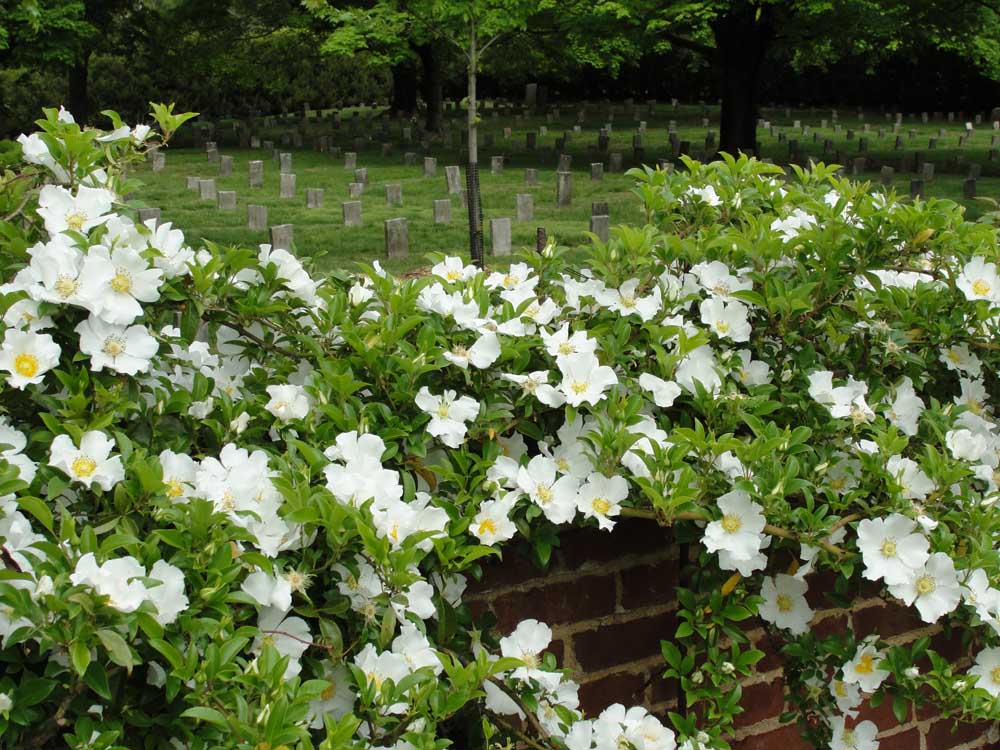Old cemeteries are collections of regional culture
Published 7:00 am Saturday, October 31, 2020

- A stunning Cherokee rose graces a historic Southern cemetery.
Today is All Saints Day and tomorrow is All Souls Day (the Day of the Dead) where the life and death of love ones is celebrated throughout Latin America. With deep reverence, cemeteries are festoon with traditional foods and flowers.
Throughout history, cemeteries not only served as a resting place for our loved ones, but as a garden of heirloom plants as well. Unfortunately, these historic collections of local customs, artistry and time-tested plants are rapidly becoming a phenomenon of the past. These days, the “perpetual care” cemetery, a blanket of manicured turfgrass and plastic flowers, has all but replaced our heritage graveyards.
Instead of the mass-produced tombstones you find today, Southern cemeteries used to offer a wide variety of markers fashioned from a range of materials, including wrought iron, native stone, and wood, side by side with those professionally carved in granite and marble. And because curbing was popular, gravesites used to be perfect raised beds for planting plants. This curbing now protects any surviving plants from mowers and string trimmers.
Gravesites were often decorated with such things as seashells, marbles, and toys. The presence of such symbols in our cemeteries actually traces back to pagan influences. There’s also evidence of our African heritage in the old-time Southern cemeteries, with that culture responsible for scraping and sweeping to keep the soil clean and bare. Long before turfgrass, herbicides, lawn mowers, and string trimmers, our cemeteries were kept meticulously barren of grass and weeds.
Plants of all kinds were planted in our cemeteries of the past. Many had religious connotations, such as evergreens symbolizing everlasting life. Anything remotely resembling a lily was considered a flower of death which is how Crinum, Lycoris, Hymenocallis, and Narcissus, as well as true lilies (Lilium), all found their way into the cemeteries. Many of our cemetery plants were originally symbols of the Mediterranean “great mother,” which later came to symbolize the Virgin Mary. Other common cemetery flowers included roses, crapemyrtles, and irises. White cemetery iris (Iris x albicans), often planted on graves in the Middle East centuries ago, is still a frequent sight today in Texas cemeteries.
It was once a custom to plant a deceased one’s favorite plant on their grave. Long after their popularity waned, many of these plants cling to life in our older cemeteries today. Oftentimes these cemeteries may be the only source of certain cultivars and species. A number of antique rose cultivars have been rescued and reintroduced into the nursery trade from cemeteries.
It is sad to see trees cut down, shrubs mutilated by string trimmers, roses sprayed with herbicides, and bulbs and wildflowers mowed before their time. Some have even gone so far as to banish living plants from the cemetery.
The old cemeteries are collections of regional culture. We used to maintain our cemeteries in annual get-togethers, when whole families would assemble to tend the graves of loved ones. Why not return our cemeteries to their role as family meeting places, cultural museums, and historic botanical gardens?
Greg Grant is the Smith County horticulturist for the Texas A&M AgriLife Extension Service. He is author of Texas Fruit and Vegetable Gardening, Heirloom Gardening in the South, and The Rose Rustlers. You can read his “Greg’s Ramblings” blog at arborgate.com, read his “In Greg’s Garden” in each issue of Texas Gardener magazine (texasgardener.com), and follow him on Facebook at “Greg Grant Gardens.” More science-based lawn and gardening information from the Texas A&M AgriLife Extension Service can be found at aggieturf.tamu.edu and aggie-horticulture.tamu.edu.






